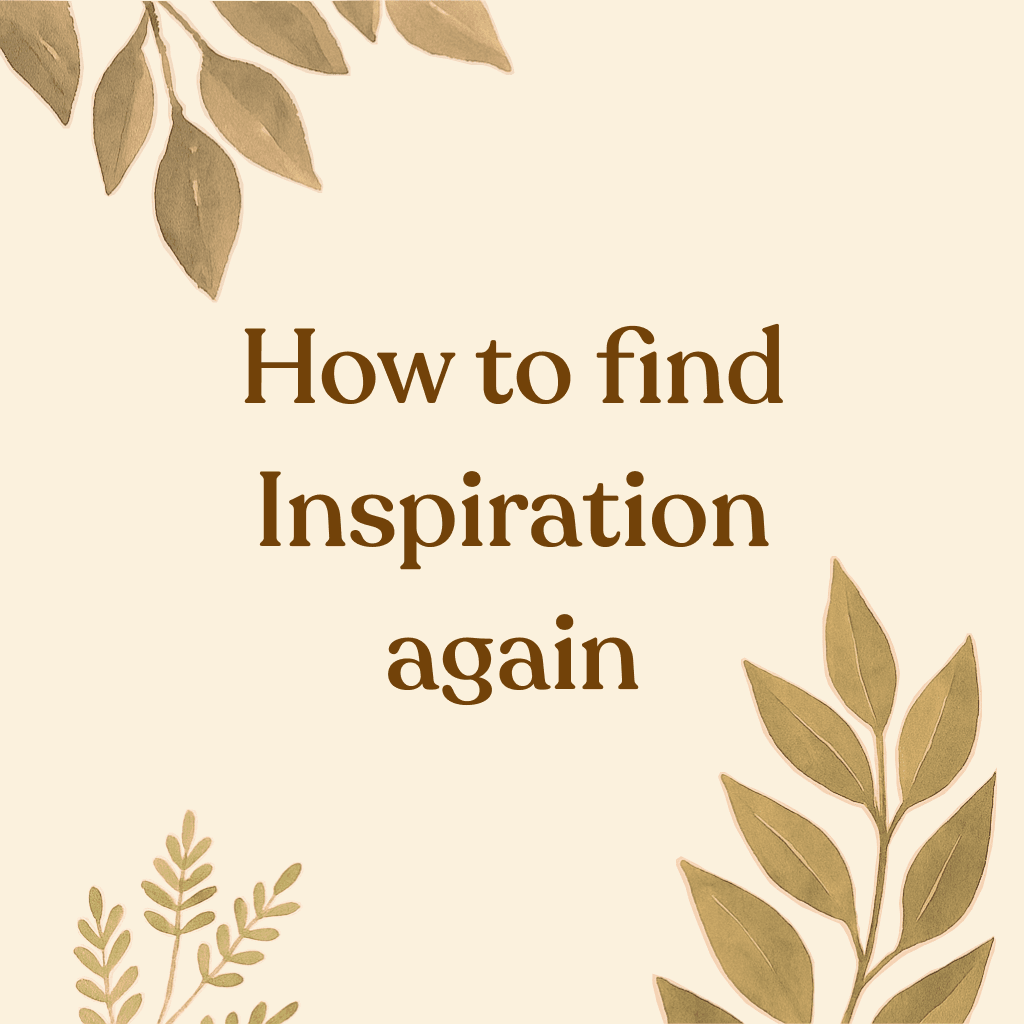How to find Inspiration again: 14 ways
7/23/2025

How to return to your rhythm - without forcing it
Inspiration doesn’t always arrive as a bright flash or a clear path. More often, it shows up quietly - in the background, between tasks, or while you’re doing something else entirely. If you’re feeling stuck, it may not be because you’ve lost your creativity. It might simply be that you’ve lost connection with the conditions it needs to resurface.
This isn’t a list to push you forward. It’s an invitation to come back to your own rhythm, and to the kind of attention that makes creative work feel alive again.
1. Pinterest - yes, really
It may sound obvious, but there’s a reason Pinterest remains such a useful tool for creatives. It’s not about finding the next big idea - it’s about noticing what repeatedly draws your eye.
Try scrolling without searching for anything in particular. Let your curiosity guide you, not your goals. Patterns will emerge if you let them.
✧ Let yourself collect before you create.
2. Visit handmade markets or local shops
There’s a tactile richness in seeing and touching materials in real life. The weight of linen, the scent of wood, the texture of unglazed clay - they stimulate parts of your mind that screens can’t reach.
Wandering without a plan often leads to small sparks. You don’t need to know why something catches your attention right away. Just trust that it did.
✧ Trust the pull. Buy one thing that makes your fingers itch with possibility.
3. Nature
Go outside - and pay attention. Nature isn’t just a backdrop. It’s a teacher in letting things unfold in their own time. Walk slowly. Notice how light changes, how trees curve, how silence feels. There is no rush in nature - and yet everything grows.
✧ Nature’s patterns are already inside you. Let them wake up again.
4. Conversations with strangers
Sometimes, the right story or phrase from someone outside your usual circle can create an unexpected shift.
This doesn’t require deep conversation. A passing remark, a fresh worldview, even a casual interaction can loosen something inside.
✧ Be open to being surprised by someone you didn’t expect to learn from.
5. Revisit familiar art - books, music, films
Don’t chase novelty. Instead, return to something that once moved you — a song, a film, a passage from a book.
You’ve changed since you last heard it. It will speak differently now.
✧ Let someone else’s words realign your own.
6. Old notebooks or sketches
Past ideas aren’t always obsolete - sometimes they were just early. Reread old notes, sketches, voice memos. Often, there’s a seed you didn’t realise was worth keeping. Now, with distance, you might see it more clearly.
✧ Revisit your own beginnings. You might find something waiting.
7. Moving your body
Physical motion unlocks mental flow. Go for a walk, stretch, dance around your kitchen. Movement interrupts loops of overthinking and gives the mind a new rhythm to follow.
✧ The mind doesn’t always lead - sometimes the body goes first.
8. Tidying your creative space
This isn’t about productivity or minimalism. It’s about creating space for something new to arrive.
Clear your desk. Organise your tools. Put away the distraction that’s been sitting there for weeks.
✧ Physical clarity can make space for mental clarity.
9. Local adventures
You don’t have to travel far. Try a different coffee shop, a park you haven’t walked in, a small museum nearby. A change in scenery - even a subtle one - can activate new parts of your brain and your senses.
✧ Change the scene, even just a little. Let it change you back.
10. Try a new medium
You don’t need to be good at it. The point isn’t mastery - it’s movement.
If you write, try sketching. If you sew, try taking photos. Creativity expands when we loosen our attachment to one form of output.
✧ Play like no one’s watching. Especially your inner critic.
11. Listen, and only listen
Put on a podcast, a lecture, or an interview - and don’t multitask. Just sit. Let the voice of another creative soak into your thoughts. It’s rare to let one input in at a time - and that’s exactly why it helps.
✧ Silence your hands so your mind can open.
12. Journaling without agenda
You don’t need the perfect notebook or prompt. Open a blank page, digital or paper, and write what’s on your mind. One page. No editing. You’re not trying to make something useful. You’re trying to hear yourself.
✧ Let the page witness you before you ask it to serve you.
13. Teach what you know
Explain your process. Talk about your craft, even if no one is listening.
Teaching forces clarity - and sometimes, it reconnects you with why you loved this in the first place.
✧ Speak it out loud. You might hear something new.
14. Do nothing (on purpose)
Yes, it’s hard. But boredom is sacred space. Boredom creates space. In a world of constant input, stillness can feel almost unnatural but it’s essential. Step away from stimulation. Let your mind wander, unfocused. Let your thoughts settle and recombine.
✧ Make room for it. Wait. Don’t fill the quiet too soon.
🌿 Final thought:
Not everything here will work every time. But sometimes, the simplest act: a walk, a page, a pause - can shift something inside.
Inspiration isn’t a race. Let your way back to it be slow, honest, and kind
🤎 see, ya 🤎
